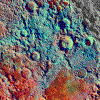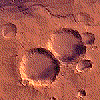
Asteroids Ida and
Dactyl from the
Galileo spacecraft.
(NASA)

Lunar craters seen in false color by the Galileo spacecraft.
(NASA)

Martian craters from the Viking orbiter: Meteorite ALH84001
could come from the small elliptic crater on the right.
(NASA)

Meteor crater (Arizona).
A meteorite weighing 300.000 tons carved it 50,000 years
ago.
Large impactors cause tremendous pressures and temperatures that can vaporize the meteorite or completely melt and mix it with melted target rocks. Certain shock metamorfic effects have been shown to be uniquely and unambiguosly associated with meteorite impact craters.
On the Earth, craters bigger than 4 km are relatively shallow and have a complex morphology with a central peak. On the Moon, at one-sixth Earth's gravity, this transition diameter is about 20 km.
Most meteoroids reaching the Earth burn themselves at heights of 50 km or higher. Meteror showers are produced when the Earth crosses a cloud of meteoroids. Many of them are dust grains that come from a comet, and ususally are smaller than sand grains.
Allmost all large stony meteorites break up with awesome sonic booms and fall in showers of thousands of pieces. Those falling on the antarctic ices are buried and accumulate in regions where the ice is removed by wind erosion (diagram by Davis Meltzer):

The biggest impactors can produce a mass extinction. In fact, many species dissapeared -dinosaurs as well- at the end of the Cretaceous period some 65 million years ago. Many scientist believe that the culprit was the meteorite that produced the big buried crater Chicxulub.


